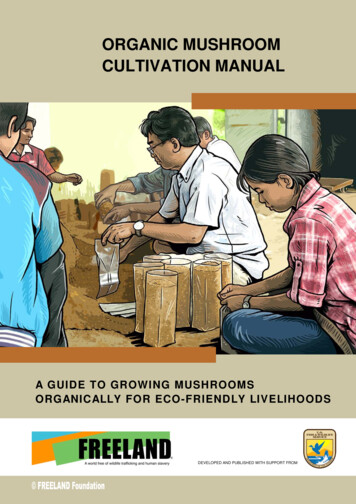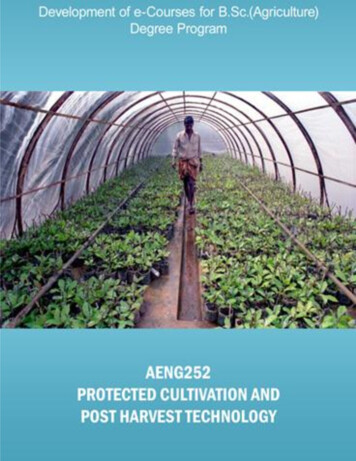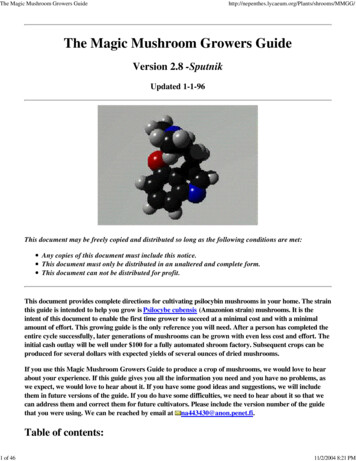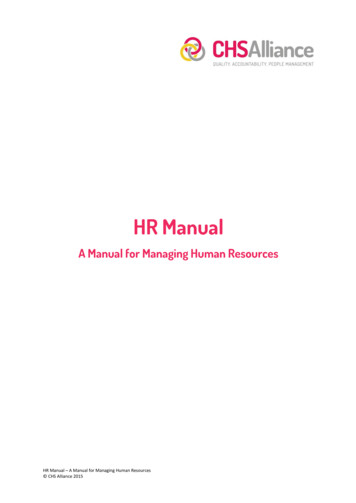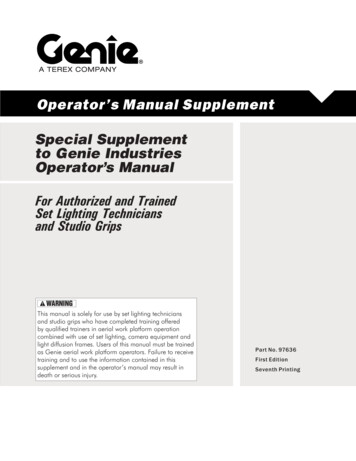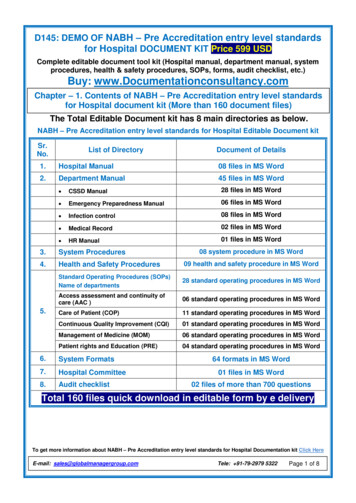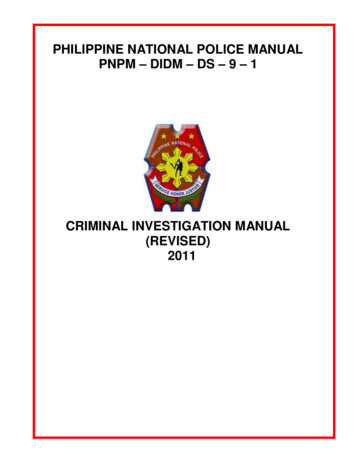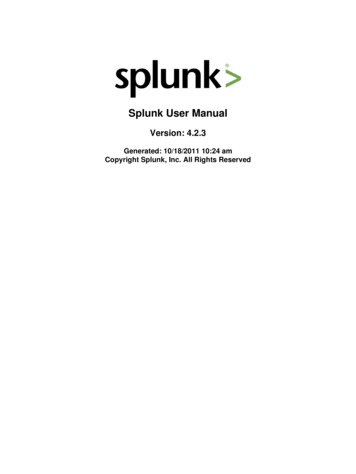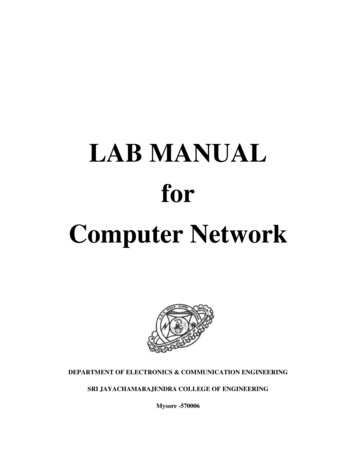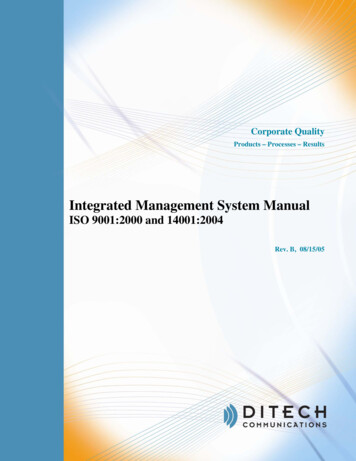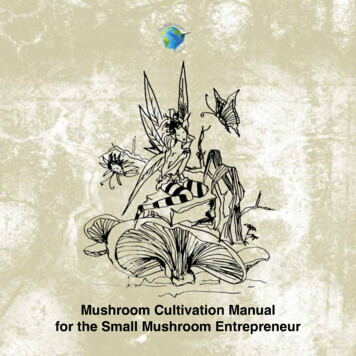
Transcription
ActionThymLUE EconoeBZERI inMushroom Cultivation Manualfor the Small Mushroom Entrepreneur
Editors: Ivanka Milenkovic, Igor MIlosavljevicAUTHORS:1. Adamović, Milan. Prof. dr. System Ekofungi2. Andersen, Ebbe Korsgaard, Beyond Coffee3. Barbero, Silvia, PhD, Assistant Professor, Politecnico di Torino4. Cox, Siemen, Rotterzwam5. van Griensven, Leo J.L.D Prof. dr., Wageningen Plant Research, Wageningen University and Research Wageningen6. Lau,Tobias, Beyond Coffee7. Lopez, Jaramillo, Carmenza8. Kadhila, Nailoke P., University of Namibia9. Matijević, Ina, B.Sc10. Milenkovic, Ivanka, System Ekofungi,11. Milosavljevic, Igor, System Ekofungi12. Mwandemele, Osmund D., University of Namibia13. Pauli, Gunter, Prof dr. ZERI Foundation14. Pecchia, John Ph.D., Assistant Professor Department of Plant Pathology and Environmental Microbiology Pennsylvania State University15. Slegers, Mark, RotterzwamArt director and illustrator: Hristina Radovic AndricTechnical support: Marija OgnjenovicPublisher: EKOFUNGI, BELGRADE, SERBIABELGRADE, FEBRUARY 2017ALL RIGHT RESERVED
CHAPTER 1INTRODUCTIONWORLD OF MUSHROOMSDr Gunter Pauli, Founder ZERI, Author “The Blue Economy”I discovered the world of mushrooms in 1994 during a meeting organised in Beijing by the RoyalAcademy of Sciences of Sweden and the Chinese Academy of Sciences. Prof. Dr. Carl-Göran Hedén,former Director of the Biology Department of Karolinska Institute, and Prof. Dr. Li Wenhua, Dean ofthe School of Environment of the Renmin University had invited a select group to discuss new waysof responding to the urgency to respond to the basic needs for people in terms of water, food, health,housing, energy and jobs. As the head of a think tank that was charged with formulating new ideas forbusiness at the United Nations University in preparation of the Kyoto Protocol, that was to become areality three years later I was a student in this room filled with scientists. Whereas all presentationsinspired me, there was one that surprised me: Prof. Dr. Shu-ting Chang, the Dean of the Faculty of Biological Sciences of the Chinese University of Hong Kong introduced the audience to his latest findingsin mycology.The simple and clear message made a lasting impression. First the fact that biowaste rich in fibresshould never be left to rot or landfill, that it should turn into a substrate for mushroom farming. Insteadof rotting debris that generates methane gas, mushrooms would produce food only emitting carbondioxide. That was a breakthrough in the run-up for the global agreement on climate change. Second,mushrooms supply a wealth and breadth of essential amino acids in such abundance that if compareddry-base with meat, it could compete. This offered an insight that was very new to me, since I was hardly acquainted with the white button mushroom and never considered it nutritious. The talk of the daywas not about this Agaricus bisporus, rather of the wealth and diversity of Chinese mushrooms whichhave been farmed over centuries including the shiitake.4CHAPTER 1 INTRODUCTION WORLD OF MUSHROOMS, Dr Gunter Pauli, Founder ZER, Author “The Blue Economy”
Prof. Shuting Chang made us realise that any country with a food processing industry could build upa mushroom business. I immediately invited him to join us for meetings in Windhoek at the Universityof Namibia, in Zimbabwe at Africa University, and in Colombia at the Federation of Coffee Farmers.His message was loud and clear: the straw of wheat, the water hyacinth from the lakes and the wasteof coffee all served as a substrate for mushrooms. When ST, as friends call this guru of mycology, satdown with Dr. Jorge Cardenas, the President of the cooperative that united 650,000 coffee farmingfamilies he strongly advised the leadership that the future of coffee is not in producing more coffee,rather the future of coffee is in the transformation of all the coffee waste into mushroom substrates.CENICAFE, the research centre of the Coffee Federation embarked on a seven year program andstudied every component from the stalks from the bush that need pruning, the pulp the is fermenting offthe beans, the silver film of the roasted coffee, and the grounds after brewing was mapped for its use.It was like finding bonanza in a world that was passing through a harsh crisis.Since only 0.2% of the coffee harvest is actually ingested, the opportunities are vast. The key is howto harness this opportunity, either on the farm, or at the point of consumption. Fortunately, a networkof entrepreneurs emerged around these opportunities. These entrepreneurs were not located in thecapital cities and were flush of cash, these were community leaders operating in the periphery of society like Carmenza Jaramillo in the peri-urban zones of Manizales, the Coffee Capital of Colombia, andMargaret Tagwira, the laboratory technician in charge of tissue culture who worked with orphan girls inZimbabwe. Both realised that mushrooms on coffee is not just a biological process, it is an opportunityfor a social transformation. Hundreds of entrepreneurs took notice and started small scale businesses.In the region of El Huila, 90 production centres were started in less than a few years and in Zimbabwe,hundreds of orphans found a new opportunity in life as the mushrooms provided them food securitywhich gave them the self-confidence to fight against abuse.When Chido Govera, one of the first orphan girls to get trained at the age of eleven in the farmingof mushrooms on grass clippings, corn cobs and water hyacinth, something that is within reach of everyone, committed to bring this technique to everyone. She traveled throughout the country (and laterthroughout Africa and beyond) and when she explained at Chipinge (Zimbabwe) to women working thecoffee farm for less than two dollars per day, that on the waste from the farm it is possible to get food fortheir children within a few weeks time, then these women would get up, sing, dance and do it. Thefarming of mushrooms once demonstrated that it works, through the cooking of a local dish, enrichedwith freshly harvested fruiting bodies, is followed-up by action. There is no need to write a strategicpaper, a business plan, a strengths and weaknesses - opportunities and threats analysis, a pilot projector a technology audit. Farming mushrooms starts with an awareness that you have all what is neededavailable, and that if you put your mind to it, and follow a few basic hygiene rules, then you will be ableto harvest perhaps even for the rest of your life.CHAPTER 1 INTRODUCTION WORLD OF MUSHROOMS, Dr Gunter Pauli, Founder ZER, Author “The Blue Economy”5
Twenty years later, there are an estimated 5,000 mushroom on coffee farms. While a few have attempted to go for large scale production (like Setas de Colombia in Medellin), and one exploited theexperiences to create a (failed) network of franchise mushroom farms, the initiatives have been growing rapidly around the world from farms in Harare, to urban initiatives in San Francisco, and innovationhubs in Rotterdam where young entrepreneurs void of any exposure to mushroom farming in the centreof the city now have trained 30 others to start their business. Prof. Chang was keen on insisting thatthe farming of mushrooms was half science and half art, and indeed when Chido Govera farms mushrooms it seems so easy, whereas others have to struggle to get going but once they master the art, itis a great satisfaction to witness the spreading of something that seems that simple and yet has manyhurdles to overcome.The main obstacle is the clarity that farming mushrooms is not just a potential business, it is also anopportunity to transform society, beyond climate change benefits. Mushrooms empower people, andprovide access to healthy food, generating jobs, while transforming available resources (unfortunately considered by many as waste), cascading food and nutrition, addressing fundamental social andecological issues. While the creation of 5,000 farming operations is by many considered a remarkableresult, it is by no means a success. The ZERI Network, this web of thousands of scientists and practitioners from around the world is convinced that the annual production of 10 million tons of coffee wastethat continues to be discarded at farms, industries and cafes or restaurants provides enough materialfor at least one million initiatives. And if we consider coffee, why not consider tea, corn cobs, sawdustand rice straw all varieties of biomass that represent an ideal substrate for mushrooms to grow. Wequickly see the creation of another 100 million tons of amino acids and the production of perhaps asmuch as 50 million tons of feed. These are major shifts in our capacity to produce food and respond toimmediate needs alleviating hunger where it is needed most. Every refugee in any camp could learnhow to farm mushrooms. And yet, we prefer to supply processed food in aluminium packs.Mushrooms are not just healthy food, mushrooms hold the potential of transforming our modern daysociety into an entrepreneurial world, where we succeed in building up a more resilient community firstand foremost because we transform biomass into food, and the waste of this food is most of the timea great feed for animals, cascading nutrition, matter and energy. It allows our economies to grow without expecting our Earth to produce more, we learn with the mushrooms how to do more with what theEarth already produces. This is a gift we received from our Chinese mentor, and a practice we learnedfrom our African, Latin American and European mycologists who worked tirelessly in propagating thisknow-how open source, sharing what we learn, and learning from each other in order to offer society achance to stamp out hunger, generate more jobs and empower young people to have a purpose in life.6CHAPTER 1 INTRODUCTION WORLD OF MUSHROOMS, Dr Gunter Pauli, Founder ZER, Author “The Blue Economy”
Mushrooms as a conventional foodMushrooms: Conventional Food andAlternative Medicine.Prof. Dr Leo J.L.D. van GriensvenWageningen Plant ResearchWageningen University and ResearchWageningen, the NetherlandsMost edible mushrooms have a number of properties in common. The most obvious is their highwater content, which varies from 85 to 95 % of their fresh weight and makes mushrooms vulnerablefor bruising and loss of storage quality. After harvest, mushrooms must be kept cool to prevent waterloss and discoloration. When this is not done properly or when mushrooms are affected by bacteria orparasitic fungi, most mushrooms will have only a very short shelf life, lose their food quality and cannotbe sold.The dry matter of mushrooms consists mainly of fibrous carbohydrates and further of proteins,(unsaturated) fats and a very high number of very diverse compounds: anti-oxidative polyphenols, vitamins, and inorganic elements as phosphorus (P), potassium (K) and magnesium (Mg), The diversecompounds are present at low concentrations but their biological effects may be impressive. Table 1shows the composition of dry matter of the white button mushroom Agaricus bisporus (from Stojkovicet al. 2014), also known colloquially as the champignon.Mushrooms as a conventional food, Mushrooms: Conventional Food and Alternative Medicine.Prof. dr. Leo J.L.D. van Griensven Wageningen Plant Research Wageningen University and Research Wageningen, the Netherlands7
Agaricus bisporusAgaricus braseilliensisAsh6.0 0.28.2 0.6Proteins3.0 0.313.3 0.2Fat1.8 0.12.8 0.1Carbohydrates89.1 0.375.8 0.3Energy384.8 0.7381.1 2.2Table 1. Main composition of cultivated Agaricus bisporus and Agaricus brasiliensis ( Agaricusblazei), expressed in grams per 100 grams dry weight.In addition to the major components shown in Table 1, mushrooms contain bactericidal and fungicidal components that form a natural protection against offensive microbials, and could also be appliedas protective agents in biological foods such as yoghurt (Stojkovic et al. 2014).The question arises whether mushrooms are a healthy food. Shii-take (Lentinula edodes) is reported to have app. 14 % of its dry weight as protein (Sistani et al. 2007), which makes it comparableto some vegetables, wheat and rice (Chang & Buswell, 1996), but it is less than that of animal meat.Further the protein seems high in glutamic acid and aspartic acid but is low in methionine and cysteine.The answer to the question is that for vegetarians mushrooms are not a very healthy food. Assuminga MDI (minimum daily intake) of 60 grams protein per day, it can be easily calculated that even a dailyconsumption of 1 kg of fresh mushrooms would not suffice. The advice is then to use a variety of leanmeat and various vegetables and or mushrooms to supply the required protein.Agaricus bisporus is a valuable source of magnesium, phosphorus and vitamin D. Vitamin Dis readily available from Agaricus bisporus and Pleurotus sp. after exposure to sunlight or othersources of UV-B light, the fungal wall component ergosterol being converted to Vitamin D2. Post harvest drying of these mushrooms in sunlight induces high amounts of Vitamin D. Different animal studies have shown that light induced edible mushrooms are safe and that Vitamin D2 is indeed available(Calvo et al. 2013). In a human experiment with 26 patients that were deficient in Vitamin D2, Urbainet al. (2011) have described that UV irradiated Agaricus bisporus could improve their Vitamin D2 statusthe same way as synthetic Vitamin D2.The energy content of mushrooms is low which makes them suited for a low calorie diet that is muchdesired in the affluent western world.8Mushrooms as a conventional food, Mushrooms: Conventional Food and Alternative Medicine.Prof. dr. Leo J.L.D. van Griensven Wageningen Plant Research Wageningen University and Research Wageningen, the Netherlands
Mushrooms can be considered a high dietary fiber food, which relates to its non-digestible carbohydrates, mainly chitin. Agaricus bisporus contains 41%
experiences to create a (failed) network of franchise mushroom farms, the initiatives have been grow-ing rapidly around the world from farms in Harare, to urban initiatives in San Francisco, and innovation hubs in Rotterdam where young entrepreneurs void of any exposure to mushroom farming in the centre of the city now have trained 30 others to start their business. Prof. Chang was keen on .
